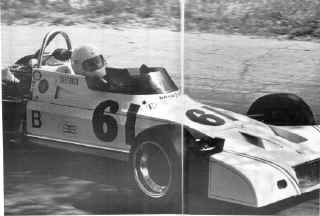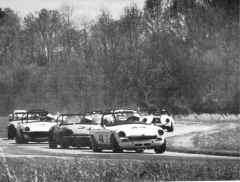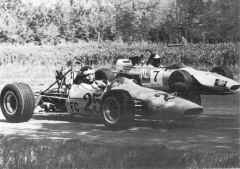VIR April 1974 Race Report
from SCCA Sports Car Magazine
RETURN TO THE ROOTS
THE FEELING OF OLD-TIMERS AT VIRGINIA INTERNATIONAL RACEWAY IS MORE
AKIN TO LOVE THAN POSSESSIVENESS
BY E. GORDON WARREN AND BILL KING

Impervious to the passage of years Chuck Dietrich
was just 0.5 of a second off the track record in his white Rondell Brabham
BT-38 FB with a time of 2:07.1. Dietrich took flrst place in Formula B and
first overall in the fifth race. Photo: Rick Bailey/Group 35
Photography
The 3.23 winding miles of Virginia International Raceway's asphalt
follow the rolling terrain that lies in a bend of the Dan River on the state
line near Milton, N.C., a National Historic District because this small town
survives as a way of life discarded by Twentieth century society. Indeed,
among old timers at VIR, who pay a constant, curious attention to the condition
of the trees, grasses and wildlife - the permanent inhabitants of the land
- there also remains a strong sense of place. The circuit came to life during
that incredible period from 1955 to 1957 when sports car racing, having been
legislated off the public roads onto mostly airport circuits, returned with
a vengeance on the new closed circuits. During that period, in addition to
VIR, Bridgehampton, Laguna Seca, Lime Rock, Marlboro, Road America, and the
third Glen circuit opened, all fitting Sylvia Wilkinson's description as
"your favorite country road in captivity."
Race courses have come and gone and changed. But VIR remains the same
track that was beloved as the most challenging course in the East at end
of the Fifties. What changed was racing. The big sports cars and their drivers,
such as Carroll Shelby, who won the inaugural at VIR in a 4.5 Maserati, and
Walt Hansgen, who ruled with D-type Lister-Jags, moved on to Europe or to
the USRRC. And the National races became the domain of the amateur driver
with the majority of the field made up production cars.
It became apparent that VIR was too far south for majority of the
drivers from the Northeast, and too far north for the majority of those in
the Southeast. With classes getting thin, exotic machinery and spectators
became equally scarce, and National races at VIR became a luxury. The big
course safety drive nearly killed SCCA racing at VIR. But the promoter managed
the required changes, and the Spring Nationals were run again in 1973, after
a two-year hiatus, only to be greeted by rain and ankle-deep mud. The decent
size of the field and the spectator turn-out gave heart to the North Carolina
Region and planning was initiated to improve the racing program.
The Region established a Task Force on Racing Facilities to do short-
and long-range planning and to serve as a sounding board for ideas. An eight-page
questionnaire was distributed to drivers, crew and workers at the October
Regional, soliciting suggestions for improving the racing program. Using
this valuable data, priorities were assigned various tasks. Starting the
first weekend in February and continuing every weekend to the April race,
groups of people showed up at the track to fix, repair, and paint. Communications
poles were moved farther from the track. A new, dual-circuit overhead system
was installed. Observation towers were erected at critical points. Ditches
were filled. A new tech-impound area was set up, the old pagoda reburbished
and an enclosed medical facility begun.
Materials and equipment were begged, borrowed, or scrounged. Eighty
people donated their time and services, including 65 on the open work weekend.
The final stroke was postponing the race date to late April in hopes of escaping
traditional heavy spring rains. On the weekend of April 20-2 1, it all came
together.
The pre-entry showed a good field, enchanced by some old-timers from
the North. The weather stayed clear and sufficiently warm, and spectators
were out in decent force to be rewarded by some great racing. The North Carolina
Region held its breath until the last practice session Saturday in hopes
of a sign that this event would be a success. And behold, the first car to
take the checker and beer flag was the Budweiser Camaro- Yes, it was going
to be that kind of a weekend.
In Sunday's eleven-lap opener, C Sports/Racing was grouped with the
rest of the little fellows, G and H Production, D Sports/Racing, and C Sedan.
Although they had the front of the grid nailed down, it was the end of the
race that eluded the C S/R group. Southeast Division champ Brian Little never
got much past the pace lap, and when a chunking tire knocked Gene Woodruff's
Royale out of a commanding lead on lap five, the race settled down to a
production car bash of first rate quality. It took a new GP lap record by
National Champ Rick Cline to fend off Joe Hauser's Sprite for first overall.
Al Beasley lowered the D S/R standard 2.2 seconds in finishing third, while
quick Randy Canfield booted his bugeye home fourth, slicing 3.2 seconds off
the HP lap record. Jerry Wannarka's Alfa GTA Jr. got the nine-point prize
in C Sedan.
Right after lunch, 28 Formula Vees took the green, five of which sailed
off into the front as an age-before-beauty parade began. Harvey Templeton
calmly surveyed the dice for the lead from the lead, as the madding crowd
dropped back one at a time. Bob DeMarco first, then Curt Newport, then
simultaneously Charles Atherly and Jeff Carlin. The latter two provided closing
lap heroics with Carlin nipping by for second. The new FV lap record belongs
to Curt Newport by a second, but the nine points belong to the old grey fox
from Winchester, Tenn.
 |
Brian Fuerstenau in his Group 44 MGB leads
Pete Vander Vate, 31, and teammate John Kelly, 4, as well as the rest of
the pack throughturn three at the start of the D, E, and F Production race.
Fuerstenau led the entire race to win. Photo: Rick Bailey/Group 35
Photography
|
The D, E, F Production race was looked to with much anticipation
especially since FP driver Number One-John Kelly-and FP driver Number Two-Rick
Cline-from the 1973 CSPRRC were going after the VIR master, Pete Vander Vate
in a little old Spitfire from Falls Church. Anyway, what Group 44 did to
the chassis and what Pete did after that produced perhaps the most startling
performance of the weekend. Not only did Vander Vate drive right away from
Kelly and Cline, he also stayed close enough to Brian Fuerstenau's Group
44 MGB and Jim Fitzgerald's Datsun 2000 to raise more than one eyebrow. Lap
records were destroyed: Fitzgerald (DP, 2:19.5 by 5.1 seconds); Fuerstenau
(EP, 2:20.0 by 7.1 seconds); and Vander Vate (FP, 2:21.3 by 7.2 seconds).
Fuerstenau took the lead on the eighth lap, when Fitzgerald lost fifth gear,
and was overall winner. But the race was Pete Vander Vate's.
Fourth race of the day brought the Showroom Stockers to the line,
all six of them. Now, six quiet cars can get lost very easily on 3.2 miles
of track unless there is close competition. Dave Roethel came from the rear
of the grid to provide just that with his Opel GT, but could never quite
make it past Robert Jones' Porsche, despite much arm waving and horn blowing.
The race for all the other formula classes had Chuck Dietrich circulating
his FB Brabham BT-38 some 0.8 seconds off the absolute course record set
in 1969 by John Gunn in a FA Lola-Chevy at 2:06.3. Dietrich put on an impressive
demonstration despite a lack of competition and gave the spectators a good
look at what European Formula Two is about. Even more exciting was the charge
through the field by Harry Ingle in his FSV Zink. Ingle, George Batchelor,
and the Marrs'Team made the tow to VIR after the Gold Cup Series event at
Road Atlanta on Saturday. Since they were unable to qualify, they were gridded
at the back of their class, positions 22 through 25 in a field of 33. When
the green fell, Ingle flashed through to tenth on the first lap, sixth on
the second, and was second overall by lap three. Once clear of traffic, though
too far back to catch the flying Dietrich, Ingle cracked off the third-fastest
lap ever run at VIR, only 0.7 seconds slower than Dietrich's new Formula
B lap record and a new FSV record by seven seconds. F.W. Marrs made his way
to third overall, while Buzz Marcus' fourth place carried off FF
honors.
The big iron feature race was, for a change, the real feature race.
Jim Fitzgerald in the Bob Sharp Racing 260-Z set out in practice Saturday
to give his first driving lesson as part-owner of the newly-formed
Fitzgerald-White School of Motor Racing located at VIR. The lesson turned
out to be "what- to- do- while- porpoising- through- a- rutty -field- with-
your- throttle- stuck- open- and- your- steering- broke- all- to- hell."
These shenanigans caused the Fitzgerald Team to do an all-nighter back at
the Clemmons, N.C., garage putting the front of the Z-car back where it was
designed to be. Since Fitzgerald had not completed any qualifying laps, the
next problem was where to grid him. In a decision that seemed infinitely
fair, he was placed in the middle of the eighteen car pack, behind all but
one of his C Production competitors. Fitzgerald complained that the spectators
were being robbed of a good race by sticking him so far back. As it turned
out, gridding Fitz dead last would have been best for the spectators. When
the flag dropped, the 260-Z shot from the fifth row through several holes
seemingly narrower than the car into fourth place going into the first turn.
On lap three, he came by just in front of John McComb's Group 44 TR-6 and
just behind Doug Mills' leading Camaro. Nipping past Mills at the hairpin,
Fitz set sail. McComb's only chance was to get around the Camaro quickly,
and he wasted no time in doing so, although some body work on both cars was
wasted in the process. But Fitzgerald was not to be caught this day, especially
by a VIR newcomer, even one as skilled as John McComb. It takes more than
a couple of practice sessions to learn this 3.2 miles. Fitzgerald's drive
earned him a new CP lap standard at 2:16.4. Mills lowered the A Sedan record
by a second in taking third. Doc Blatchley's BP Corvette was fourth with
yet another lap record. Jim Glanton's Porsche took B S/R, while Roger Cook's
Triumph Vitesse copped B Sedan.
| Alfred Matthews, 25, and Bill Alsup are head-to-head
going into the shade of "Oak Tree" - turn twelve. Alsup finished seventh
in Formula F and Matthews finished third in Formula C. Photo: Rick Bailey/Group
35 Photography
|
 |
The North Carolina Region conducts its events in a casual, relaxed
manner with a spirit of fellowship and fun. The Region has no illusions about
running the biggest, best or fanciest racing program in the country but it
does claim one of the most challenging and beautiful road courses in the
country as its home track, as well as a desire to do everything possible
to make a weekend enjoyable for everyone involved. If the 1974 Spring National
was any yardstick, both the racers and the spectators enjoyed
themselves.